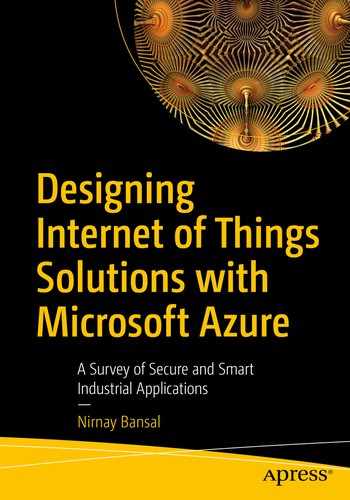Believe it or not, health care has changed a lot in recent years due to acceptance and implementation of revolutionary technologies. The greatest obvious technological leap forward in the last several decades has been the development of electronic health records (EHR) systems. Although we might think that is the biggest change because we directly benefit from EHR, actually the biggest change in recent years is how the health care industry does research, recommends medicines, and accurately diagnoses patients using technology. The increased prevalence of life-threatening diseases challenged the health care industry to integrate advanced technologies such as data analytics, machine learning, IoT, and AI.
At this point I am not debating which is the biggest change, but among all of these, in this chapter I emphasize how IoT has attained maximum consideration in the health care industry. IoT can be described as a centralized network of interconnected physical devices that can be controlled remotely using the Internet. I discuss how IoT is beneficial for everyone in this industry: patients, physicians, hospitals, and insurance companies. Later in the chapter I look at some major implementations through use cases to describe the diverse applications of IoT in medicine.
In this chapter I emphasize challenges more than benefits, because even though health care is such a vast ecosystem, full of opportunities and human priorities, the global health care regulatory bodies worldwide are gatekeepers for any new process or technology. Sometimes this slows down acceptance and implementation of new processes and technologies.
Finally, we will look at the three major stages of storage, analytics, and visualization of Apple Watch data using Time Series Insights (TSI). For the same, we will provision a new TSI environment and connect it to our IoT Hub. Finally, we design various reports, all of this without any knowledge of coding and query language.
Health Care
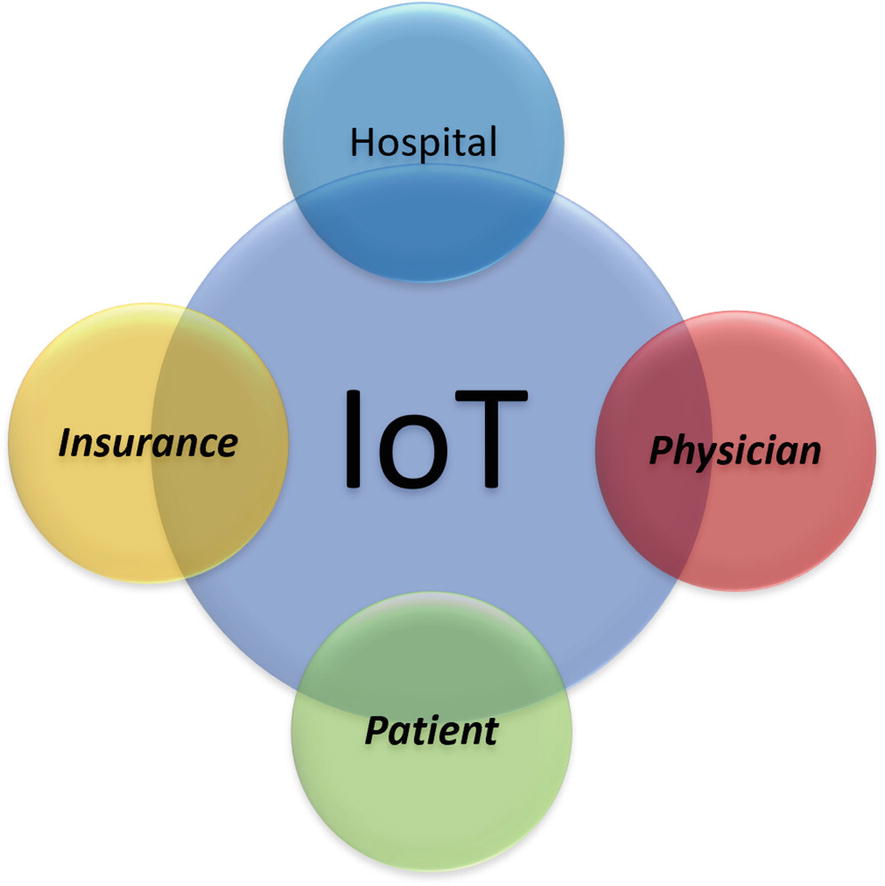
Stakeholders of IoT in the health care industry
IoT for Hospitals
IoT can turn a regular hospital into a smart hospital, by streamlining processes and enabling health care professionals to conduct tasks in a timely manner. Apart from monitoring patients’ health, there are many other areas where IoT devices are very useful in hospitals. Examples include tracking the real-time location of medical equipment like wheelchairs, defibrillators, nebulizer machines, and the nearest oxygen tank; maintaining near-perfect temperature of rooms and smart fridges for vaccines to keep them safe; and providing a real-time inventory of life-saving drugs. Another example is smart beds that can sense the presence of a patient and automatically adjust to the correct angle and pressure to provide proper support without the need for a nurse to intervene. All data can be tracked and collected in real time. IoT has thus provides a myriad of possibilities to enhance efficiency and convenience and even provide cost-saving alternatives to hospitals.
At the time of writing, COVID-19 was spreading on almost all continents. The spread of infection is a major concern for patients in hospitals. During this difficult time, I noted how IoT-enabled hygiene monitoring devices were helpful in preventing patients from getting infected in hospitals. The disease monitoring tools merged IoT data with GIS data, social media streams, and other sources to detect emerging public health threats from COVID-19. By collecting such data from remote locations, clinical researchers are better equipped to make an evidence-based analysis of the outbreak, suggesting preventive measures and avoiding ineffective processes other countries or hospitals used.
IoT for Physicians
I have two doctors in my family, and in my experience, physicians don’t like too many gadgets. A primary care physician isn’t going to sit and stare at a live feed of your blood pressure or check it on a smartphone on a regular schedule. However, IoT does enable physicians to make evidence-based, informed decisions and it provides absolute transparency when needed. Taking again the example of COVID-19, during this pandemic with hospitals full of patients, IoT-based health care helped physicians with remote monitoring of physiological parameters of other patients in need, like pregnant women, elderly patients, and infants. Physicians can create different metrics to see any changes in the patients’ health conditions remotely. This provides an effective interaction between the physicians and patients, leading to patient satisfaction, as they can now interact more easily and efficiently with their doctors. Medical staff can monitor and analyze patients’ condition efficiently connected to their smartphones, removing the physical barrier to diagnosis and prescribing drugs. Timely and correct diagnosis is important, and that’s exactly what IoT device provides: It helps in effective decision making by analyzing data generated through IoT devices and ensures quality health care.
IoT for Patients
Smart medication dispensers could automatically upload information to the cloud and alert doctors when patients don’t take their medicine. At first it feels like an overengineered product, but you would be surprised that among elderly patients this is a very helpful service, because if patients don’t take their medication in appropriate doses or at the right times, symptoms could worsen, increasing the threat to life. We are familiar with wearables like fitness bands (including smart watches), portable monitoring devices like blood pressure monitors, and thermometers, as other wirelessly connected devices that keep track of your vital signs like blood pressure, heart rate, distance walked, running speed, calories burned, and so on. Sharing these data with physicians allows them to spend less time on logistics and more time treating conditions and consulting with patients. These wearable devices have changed people’s lives, especially for elderly patients, by enabling constant tracking of health conditions. Devices integrated with IoT flag results in relation to a target range and can alert you to take necessary action before the onset of any disease when they pick up on critical changes in such numbers. In this chapter’s lab, we will learn how to make all these data useful by analyzing them using an IoT data analysis platform such as Microsoft Azure to draw meaningful insight and notice actionable trends.
We all are aware of such wearables, but to add value, here I would like to discuss some more intense recently developed IoT devices that are life-saving for many. Continuous glucose monitoring (CGM) devices with smart insulin help continuously monitor of blood glucose levels at regular intervals and calculate the correct insulin dose at the right time. Alternatively, you can also monitor blood glucose level with Google’s smart contact lenses (although commercialization of such a device is still far from reality.) Smart inhalers monitor the physical environment that causes asthma symptoms, and also records the number of times and the amount the patient inhales. Other notable devices are Bluetooth-capable hearing aids, ingestible pill-sized sensors, and mood-enhancing devices. Robotic surgery is now a reality. Artificial organs are already a viable alternative to waiting for organ donation.
IoT for Health Insurance
IoT is an industry-agnostic technology that includes insurance companies related to health care. The IoT has changed the way the health insurance industry currently interacts with hospitals and patients. Some well-known systems that have been working for decades are clearinghouses, EHR, online prescriptions, and online payments. Beyond this, health insurance has become one of the key industries disrupted by connected devices. I don’t know of any not-for-profit insurance companies. Just like any other business, insurance companies are also looking to make a profit, but that requires precise data to fine-tune policies to the needs of each specific customer and minimize the risk of losing funds. Like the auto industry using OBD devices to track your driving habits and offer insurance based on those data, health insurance companies incorporate devices such as biosensors, wearables, and mobile apps to track customer behavior, workout schedules, and stress levels to identify the kind of care needed for each policyholder and set the premiums accordingly. For example, residents of “Cancer Alley,” a location in Louisiana where a plant emits 99 percent of U.S. chloroprene pollution, are more likely to get cancer due to chloroprene air emissions. What do you think the health insurance premium would be for 29,000 residents of that town as compared with your town? This risk calculation helps determine the cost of the health care premium the individual will pay.
Toxic air or water is not the only cause of chronic diseases; they can arise from simple factors like poor nutrition, lack of exercise, and high levels of stress. IoT solutions combine insightful analytics and allow policyholders to avoid being generalized; they can be quoted more precisely. On the other side, collecting these data helps insurance companies launch new products, use flexible pricing models, and market specific coverage. Conventionally, customers are often directly engaged with agents or brokers. Converting this indirect customer contact to direct contact can offer considerable benefits in customer relationships as well as in handling of insurance claims.
There is one common benefit to all health care stakeholders: the Cost of health care. Using machines to deliver patient care means that health care becomes increasingly affordable for all parties involved. The data collection, reporting, and analyses become more accurate, ultimately saving time and reducing the need for in-person visits. The data collection and early warning from devices saves the cost of unnecessary lab tests. The IoT can also improve care while patients are in the hospital, cutting down on expenses for all parties.
Applications
From wearable devices to advanced analytics, there are several applications of IoT in health care. It’s hard to find an industry with more potential for IoT than health care. Wearable devices such as fitness bands, smart watches, and so on monitor real-time data, IoT-enabled labels integrated in a patient’s ID card reduce admission time in hospitals, and medical equipment can enable better management of medical resources. IoT benefits everyone associated with the health care industry: patients, physicians, and health care and health insurance companies.
Let’s have a look at some of the major IoT implementations in the health sector.
Use Case 1: Mobile Health
Mobile health, or mHealth, is an emerging field that has proved to be a true lifesaver for modern patients. mHealth is a term used for the practice of medicine and consumer health supported by mobile devices. Remote and wireless medical care solutions based on wireless communication networks are rapidly expanding. The mHealth system will benefit patients in many ways, such as quick diagnosis, remote monitoring, and home rehabilitation. mHealth is the combination of mobile apps and devices that can be used to deliver, access, or record medical information, or provide clinical services. mHealth makes use of health tracking devices such as smart watches and fitness bands connected to a central server. It can serve as a potential health care hub to collect valuable medical information and then generate medical reports. mHealth solves the problem of people who don’t get time to visit providers for regular checkups, by giving them everyday health notifications on their smartphones. There are several mHealth applications available on the market, differing in functionality and purpose.
Fitness Apps and Devices
These provide users a nudge in the right direction and help them to make certain modifications in their lifestyle and self-report these data to their health care provider. These apps can track exercise time, distance covered, calories burned, and vital signs like heart rate and blood pressure during this period. There are other devices, primarily smart watches, that track additional parameters like sleep time quality of sleep. There are already hundreds of off-the-shelf sensors, wearables, and mobile devices that can gather such data. The self-report reduces the cost and burden of travel, improves patient recruitment and retention, and captures more reliable and accurate outcomes.
Some advanced devices have the ability to continuously measure the period of time between heartbeats—a metric called heart rate variability (HRV). The variation in this metric indicates stress. The introduction of low-energy Bluetooth (4.0) is helping these devices do more with less energy. I am excited to see the changes in the more granular load of data from these devices once 5G is widely available .
Pregnancy Monitoring
Pregnancy monitoring devices are used to track pregnancy health and monitor fetal development. They can also be used to schedule doctor visits, observe the growing baby, and notify women to take prenatal vitamins. A simple ultrasound device connected with a smartphone allows health care workers to perform ultrasounds on pregnant women to see if their pregnancies are progressing normally. Because these ultrasounds can be performed almost anywhere, and the images can be shared via Wi-Fi, cellular, or USB connections, these are often used in cross-country health care services.
Use Case 2: Wearable Sensor
Ultraviolet radiation devices measure UV sun rays and warn of overexposure in certain hours.
ECG monitors can measure electrocardiograms (ECGs) and detect atrial fibrillation.
Blood pressure monitors can measure blood pressure and daily activity, like steps taken, distance traveled, and calories burned.
Biosensors are self-adhesive patches that can collect data on movement, heart rate, respiratory rate, and temperature.
Electrozyme temporary tattoos have the ability to measure lactate, a chemical compound generated by muscles. They can monitor muscular exertion, fatigue, hydration levels, and electrolyte balance.
Posture correction devices helps correct a user’s position by alerting (by sound or vibration) when he or she is walking or sitting with poor posture.
CGM devices continuously monitor blood glucose levels at regular intervals. Additional insulin sensors can calculate the correct insulin dose at the right time.
Smart nicotine patches can gradually dispense smaller doses of the addictive ingredient to help smokers try to end their addiction.
Google smart contact lenses are made for people who suffer from diabetes and those who simply wear glasses.
Smart bras have the ability to track conditions and rhythms in the breast tissue to alert to the possibility of cancer.

Exporting data from the Health app
Lab: Analyze Heart Rate Data from Your Apple Watch
Wearable devices such as fitness bands, smart watches, and so on, are integrated with real-time tracking systems and can be used to monitor and observe people’s health conditions. Patients can use wearable devices to keep track of their physical activities and monitor their overall health. The data generated by wearables can also be used by physicians for effective diagnosis and treatment. These medical devices gather information about oxygen, blood pressure, blood sugar level, ECG, and so on. These real-time patient data can prove to be critical in the case of a medical emergency such as an asthma attack, diabetes, low blood pressure, heart failure, and more.
Therefore, the data generated from IoT devices are important, but the aspect of analyzing data is where the actual benefit is. In this lab we will analyze these data using Azure TSI. TSI can be integrated with the data coming from these devices in real time or can perform an on-demand dump and conduct analysis on top of it. Such continuous patient monitoring and real-time data analysis helps in diagnosing diseases at an early stage or even before the disease develops, based on symptoms.
Stage 1: Data generation from deployed interconnected devices includes sensors, actuators, monitors, detectors, camera systems, and so on.
Stage 2: Aggregate the data. If data received from sensors are in analog form, they are converted to digital form for further data processing before aggregation.
Stage 3: Preprocess, standardize, and move data to cloud storage.
Stage 4: The final step is to analyze the data to bring actionable insights for effective decision making or trigger action.
Apple Watch does the first two steps for you, so this lab starts with Stage 3; that is, I will show you how to download the data, ingest it in Event Hub, and analyze the data generated from your Apple Watch Heart Rate monitor sensor using Azure TSI . I briefly covered Azure TSI in Chapter 4.
Azure TSI is a fully managed offering primarily developed for data generated from IoT devices that guarantees the sequential order of data arrival. TSI stores, aggregates, and visualizes telemetry and trends in graphical format without writing any code. It follows the look-back architecture used in root-cause analysis, detects anomalies, and flags low and high values. That’s exactly what we would like to do with our heart rate, blood pressure, glucose level, and oxygen level data.
Azure TSI doesn’t require any coding knowledge and does not require writing any scripts.
Exporting Apple Watch Health Data

Exporting data from the Health app

Heart rate data from export.zip file downloaded from the Health app
IoT Hub with TSI
- 1.
Sign into the Azure Portal using your Azure subscription account.
Note I assume you already have an IoT Hub. If not, follow the steps to create a new IoT Hub given in Chapter 3, as that is not a part of this lab.
- 2.
Select + Create a resource in the upper left.
- 3.
Select Time Series Insights as shown in Figure 11-5.

Azure Time Series Insight on Azure Portal
- 4.
On the Create Time Series Insights Environment page, on the Basics tab, set the parameters as shown in Figure 11-6.
- 5.
We’re going to start by creating a new resource group, but you can select the existing resource group.
- 6.
For the Tier, S1 is selected in this example, but that bills monthly and is not dependent on actual usage. I usually recommend choosing the PAYG (Preview) tier. The downside is that you must create your own storage and partition keys. For this lab, these extra settings could be confusing and therefore I prefer the S1 tier.
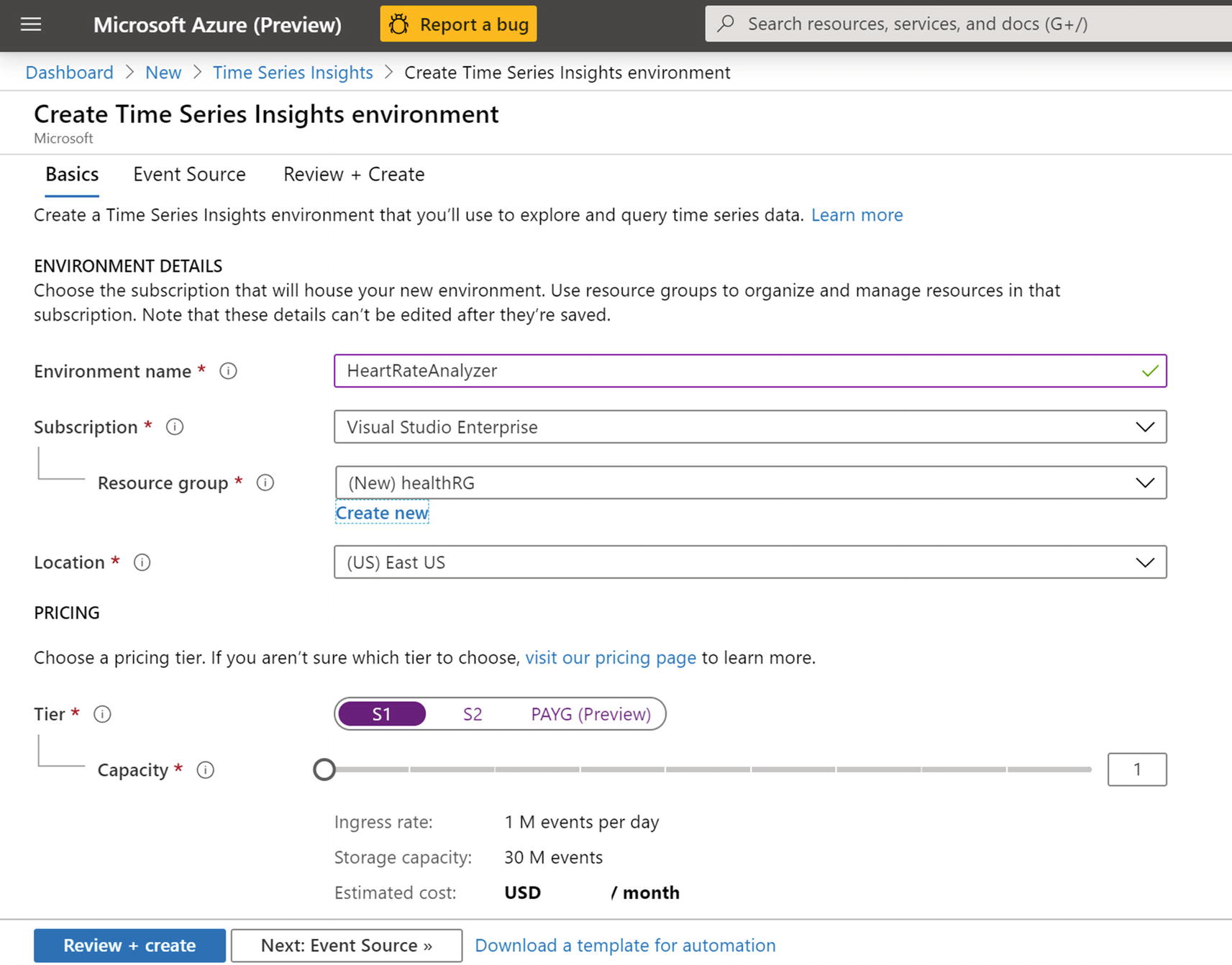
Creating a new new Azure Time Series Insights environment on the Basics tab
- 7.
Click Next: Event Source or click the Event Source tab. Set the parameters as shown in Figure 11-7 to select the existing IoT Hub.
- 8.
Click Review + Create.
- 9.
Click Create and wait for the resource to be created. It might take few minutes to provision.

Event Source tab to create a new Azure Time Series Insight environment
Stream Data
There is no easy way to send the data you exported from Apple Watch to IoT Hub or Event Hub. As this chapter is focused on TSI, I will leave it to the user to provide real heart rate data. For now, I am using Visual Studio Code to quickly send hundreds of heart rate messages to IoT Hub, as shown in Figure 11-8.
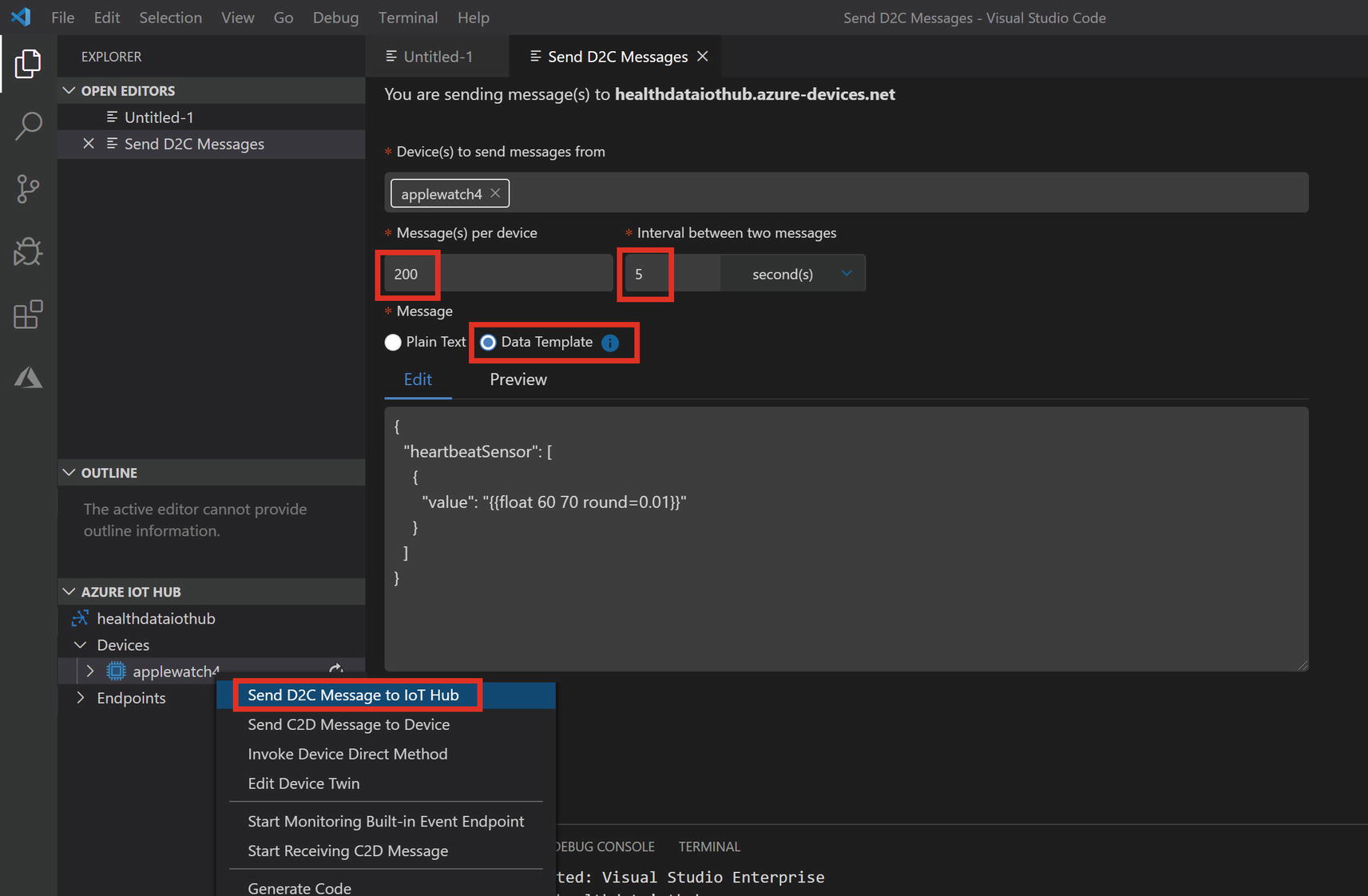
Simulating heart rate using Visual Studio Code
Exploring Reports

Time Series Insights perspective explorer (dashboard)
Our dashboard is divided into three sections. On the left there are query options and on the right is the visualization of our current query. At the bottom, we can see the raw events or statistics from our result set.
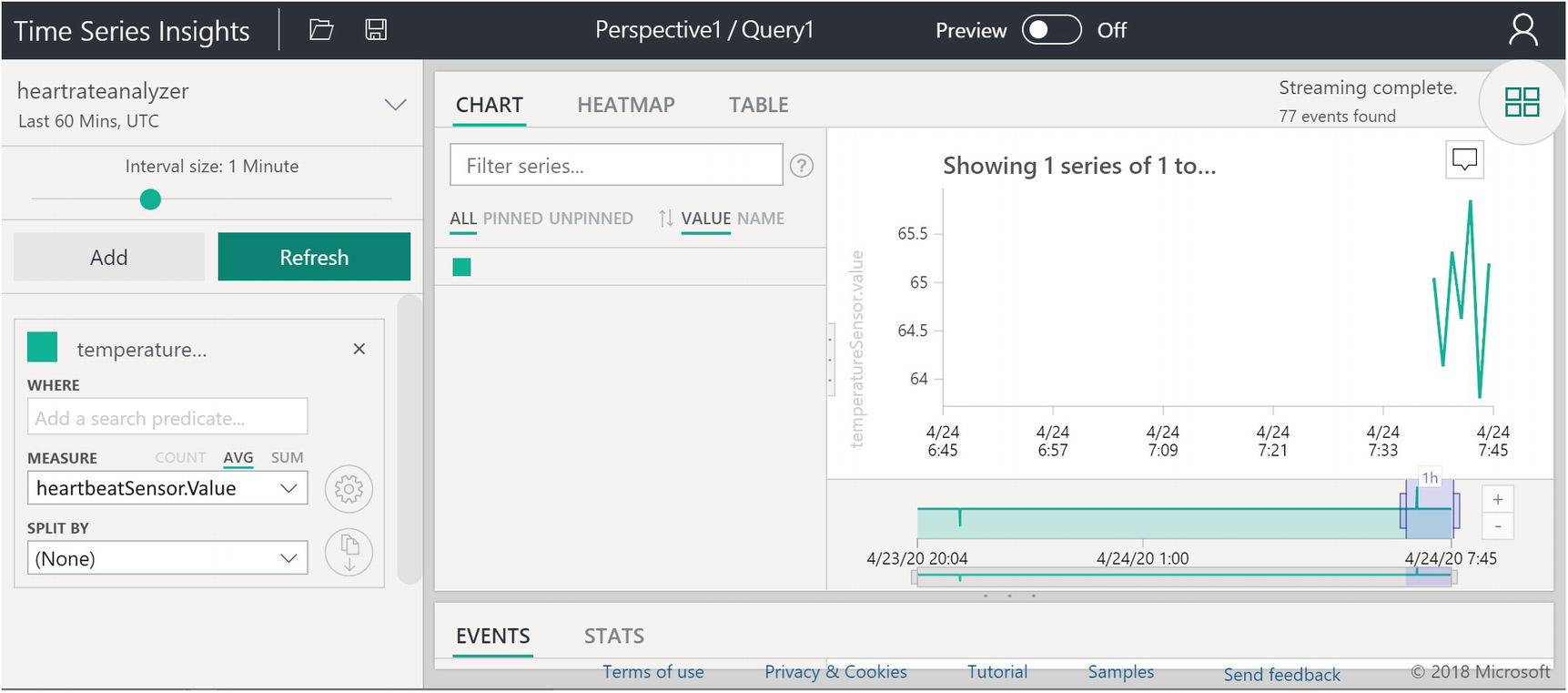
Perspective on heart rate values

Event received on heart rate
Congratulations! You just have visualized your health data using Azure TSI.
Other notable reports are the HeatMap chart and Table-based report of the same data. Based on different sensor data from your Apple Watch like ECG, blood pressure, and heart rate, you can create up to four different reports by clicking the tile button in the top right corner.
This process would be mostly the same with real data because TSI is built for this type of analysis on an IoT scale with time-series data sets.
TSI Preview has some notable changes. For example, you can create a model to enhance your browsing and visualization experience. You can add types, hierarchies, and instances to complete your model. Because this is in preview mode, I will leave it to you to further explore new features when Generally Available (GA).
TSI is costly because we selected the S1 tier. You can either delete the entire resource group by selecting Delete or remove TSI only.
Benefits of IoT Application in Health Care
Affordability: Using devices to offer patient care makes health care increasingly affordable for all parties involved. Use of IoT solutions and connected medical devices in the Health care sector provides real-time patient monitoring to the medical staff. Efficiently automated health care systems require less maintenance and can be employed long term. Furthermore, these systems reduce unnecessary visits to the hospital and provide accelerated diagnostics and treatment.
Better patient experience: IoT-enabled health care systems involve better engagement of patients in their treatment. Patients can regularly monitor their own health status through wearable devices. These devices also enhance the diagnosis process by providing doctors digital reports. This ensures medical staff has to spend less time looking for drugs, tracking supplies, and monitoring hygiene processes in the hospitals. It also ensures patients adhere to their treatment procedures and facilitates tracking of patient compliance with medical prescriptions.
Reduced wastage and errors: Using IoT for medical data collection and hospital workflow automation can curtail waste related to medical tests. It can also reduce system errors that can occur in ordinary hospital systems.
Improved treatment outcomes: IoT-based health care solutions are integrated with the concept of big data and cloud computing. They allow doctors to access real-time health status of patients, so they can make better decisions that will enhance treatment outcomes.
The future of IoT in health care is very bright. Regular use of common things on a global scale to reduce physical visits to hospitals is only a small picture of the success of the IoT in medicine. Business Insider estimates that the installed base of IoT devices in health care will be more than 161 million units by the end of 2020. I am pretty confident that if you ask most medical professionals about their opinion on the subject, they will say that full IoT integration and adaptation is the only logical way foward for the advanced medicine of the future. The results are higher efficiency and reduced waste. That is just the beginning of a future where medical systems work to their fullest potential.
Challenges of IoT Application in Health Care
IoT applications in health care facilitate the lives of both patients and health service providers. Although IoT implementation in the health care sector seems to be revolutionary and highly effective, there are still a number of challenges posed by IoT applications in this sector. In certain situations, these challenges nearly outweigh the benefits. The following are some of the major challenges of adopting IoT in health care.
Data security and privacy challenge : Data security and privacy are among the most significant challenges posed by IoT implementation in any industry, but this challenge is greatest in the health care industry. Security is the most pressing concern about the IoT in health care. IoT-enabled devices collect real-time patient health data, which are categorized as confidential information. Therefore, these data provide a myriad of opportunities to cybercriminals and are susceptible to privacy threats. The U.S. government enacted guidelines in the Health Insurance Portability and Accountability Act (HIPAA) on how to store, process, and use medical data. Most of these devices do not follow proper data protocols and standards, however, because of ambiguity in ownership. The legal parameters for using data collected from connected devices are being defined by government bodies and must be verified as well as audited for risk assessment regularly. Such security does increase the overall cost. Many consumers are ready to pay for premium services with advanced security. A more detailed list of other cybersecurity issues is provided in Chapter 14.
Integration of multiple devices and protocols: The implementation of IoT in the health care sector is hindered by integration of multiple devices. Medical device manufacturers have no standard communication protocols and standards for medical equipment. As a result, each medical device manufacturer establishes its own environment for IoT devices that cannot interact with devices of competing manufacturers. This nonuniformity of synchronous data protocols slows down the process of data aggregation and curtails the scope of IoT in the health sector. The medical IoT still has to be approved by global health care regulatory bodies. This will take time and might keep many innovations at bay because of formalities. Another challenge is handling regular updates. The software must be regularly updated with the latest version to run devices securely. Such constant updates will require great effort and might spawn many technical issues.
Data accuracy and overload : For IT departments of health care facilities, the sheer amount of data that comes through connected devices can be overwhelming, requiring a steep learning curve. IoT-enabled devices gather data in bulk that needs to be processed in small chunks for better accuracy of results. However, due to nonuniformity of communication protocols and standards, it becomes quite difficult to collect the data required to gain insights and analysis. As a result, data segregation without overloading becomes nearly impossible, which affects decision-making procedures in the health care sector over the long run.
As previously mentioned, systems can be hacked. Lots of attention will need to be focused on data security, which requires significant spending.
Despite these challenges, the future of health care will undoubtedly involve the IoT. International health governing bodies are already issuing guidelines that must be strictly followed by medical establishments integrating the IoT in their workflow. One such guideline issued by the U.S. Department of Health and Human Services on cybersecurity best practices for medical device manufacturers is available at https://www.healthit.gov/sites/default/files/page/2020-02/Medical-device-manufacturers-IOT-Code.pdf. Such guidelines could restrict possible innovations to some extent, but that will improve over time.
Summary
IoT is set to transform the health care sector even more in the coming years. IoT has played a specific role in improving quality of life and creating a new technological environment in health care, helping medical organizations to manage the bottlenecks of care and bridging the gap between health service providers and patients.
I analyzed IoT in health care using two different use cases, mobile health and wearable devices. The integration of IoT in these health care sectors has brought numerous benefits. mHealth serves as potential health care hub for monitoring patients’ health using smartphones.
We discussed several benefits of IoT in health care, such as cost savings, better drug management, better patient experience, and reduced waste. However, any advancement in technology poses some challenges. Health care is no different: With game-changing IoT integration in the health care sector there arise myriad of technical difficulties and adoption issues like data security, integration of multiple devices, and accuracy.
At the end we used TSI to pull data from IoT Hub using a mechanism that involves the existence of a consumer group and created a report using Apple Watch heart rate data exported using the iPhone Health app.
